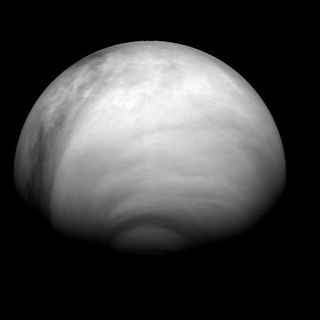Venus and Mars: Surprising Similarities Found

Mars and Venus, those seemingly contrasting planets ofself-help book fame, have more in common than you might think. Two nearlyidentical spacecraft around Mars and Venus have compared the two worlds'atmospheres and found them to be surprisingly similar.
The ESA's MarsExpress and VenusExpress are currently in orbit around the planets taking measurements oftheir atmospheres as they interact with solar radiation. The data show thatcharged particles from the gas layers around both planets are being scavengedby solar wind and storms.
"Mars and Venus are very different planets," saidDavid Brain, a planetary scientist at the University of California, Berkeley,and a supporting investigator for Venus Express. "Venus's atmosphere isvery thick, dry and hot, and Mars's atmosphere is very thin and cold. And yetthe same processes are happening on both planets."
Both Venus's and Mars's atmospheres are about 95 percentcarbon dioxide. Earth's is mostly nitrogen now, but scientists think it used tobe more like the other rocky worlds.
Because neither of our neighboring planets has a global,protecive magnetic field, the solar wind is free to interact directly with theplanets' atmospheres. Solar radiation energizes atmospheric particles so thatthey accelerate and escape from the planets. Earth is spared from the brunt ofsolar radiation by its protectivemagnetosphere.
"These results really highlight what a special placeEarth is and how lucky we are to have an atmosphere protected by a magneticfield," Brain said.
By analyzing the spacecrafts' treasure trove of data,researchers hope to learn how these two planets' climates have changed overtime and to compare their evolution to Earth's atmosphere.
Get the Space.com Newsletter
Breaking space news, the latest updates on rocket launches, skywatching events and more!
"We want to understand why Earth is different from Mars,why is it different from Venus, why are the inner planets different from theouter planets," Brain told SPACE.com. "As a scientist it'samazing to have the same set of measurements at both planets simultaneously. Agreat example is the solarstorm. We got to see the same event measured at two different places."
In December 2006, a powerful solar storm erupted, sprayingjets of charged particles outward. Venus and Mars were smacked with radiation,causing particles in their atmospheres to gain energy and escape ? Mars lostatmospheric particles 10 times faster than it usually does.
"I like to think of the solar storms as tsunamis in theatmospheres of the planets," Brain said. "It was very intense andsaturated many of our instruments. It was a lucky encounter, maybe not for theatmospheres, but for us who were watching."
- Video:Danger! Solar Storm
- Marsin 3D: Images from Mars Express
- ImageGallery: Mars Express ? A Year of Discoveries
Join our Space Forums to keep talking space on the latest missions, night sky and more! And if you have a news tip, correction or comment, let us know at: community@space.com.

Clara Moskowitz is a science and space writer who joined the Space.com team in 2008 and served as Assistant Managing Editor from 2011 to 2013. Clara has a bachelor's degree in astronomy and physics from Wesleyan University, and a graduate certificate in science writing from the University of California, Santa Cruz. She covers everything from astronomy to human spaceflight and once aced a NASTAR suborbital spaceflight training program for space missions. Clara is currently Associate Editor of Scientific American. To see her latest project is, follow Clara on Twitter.
